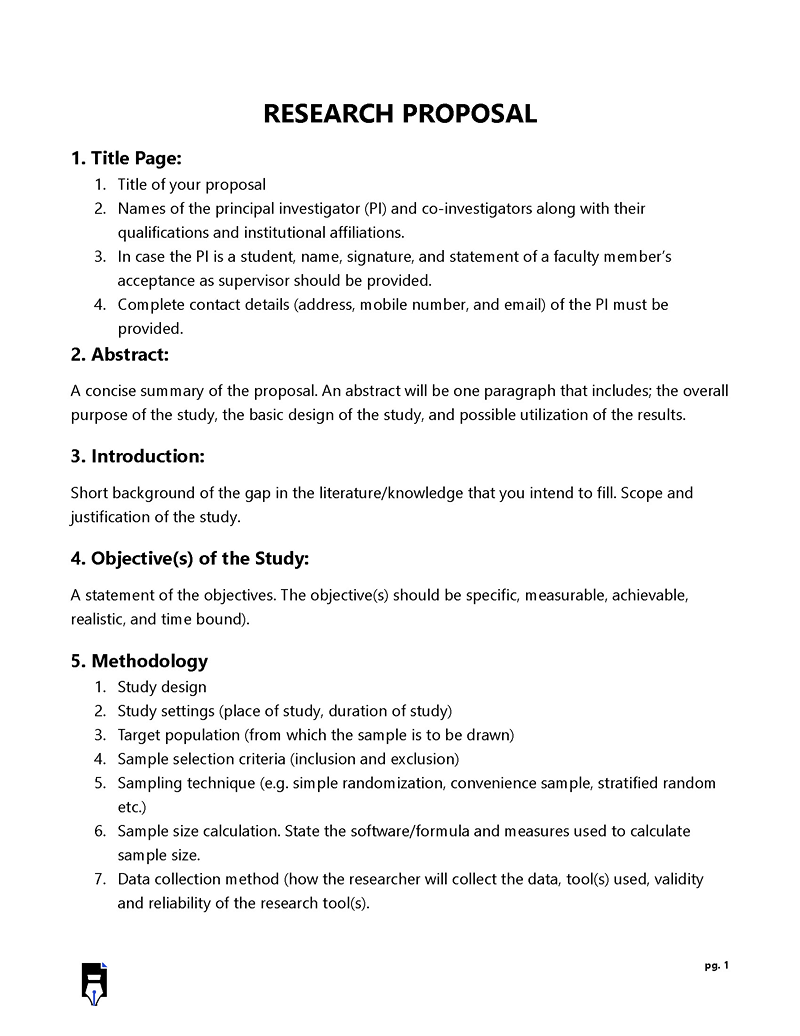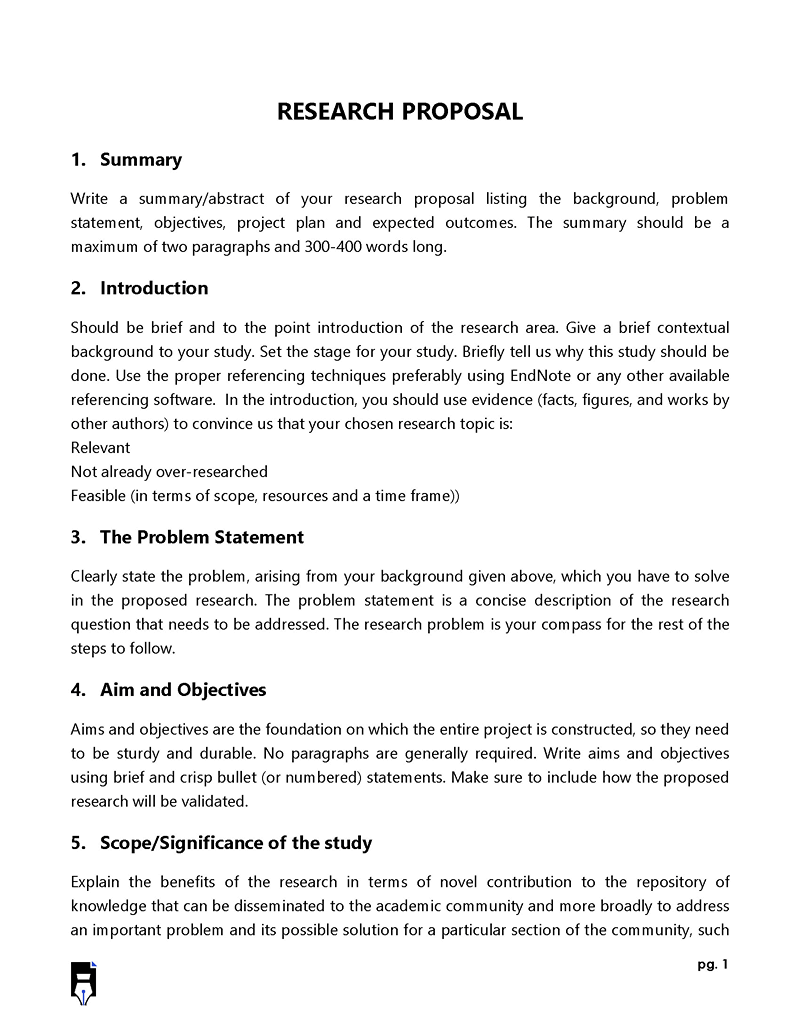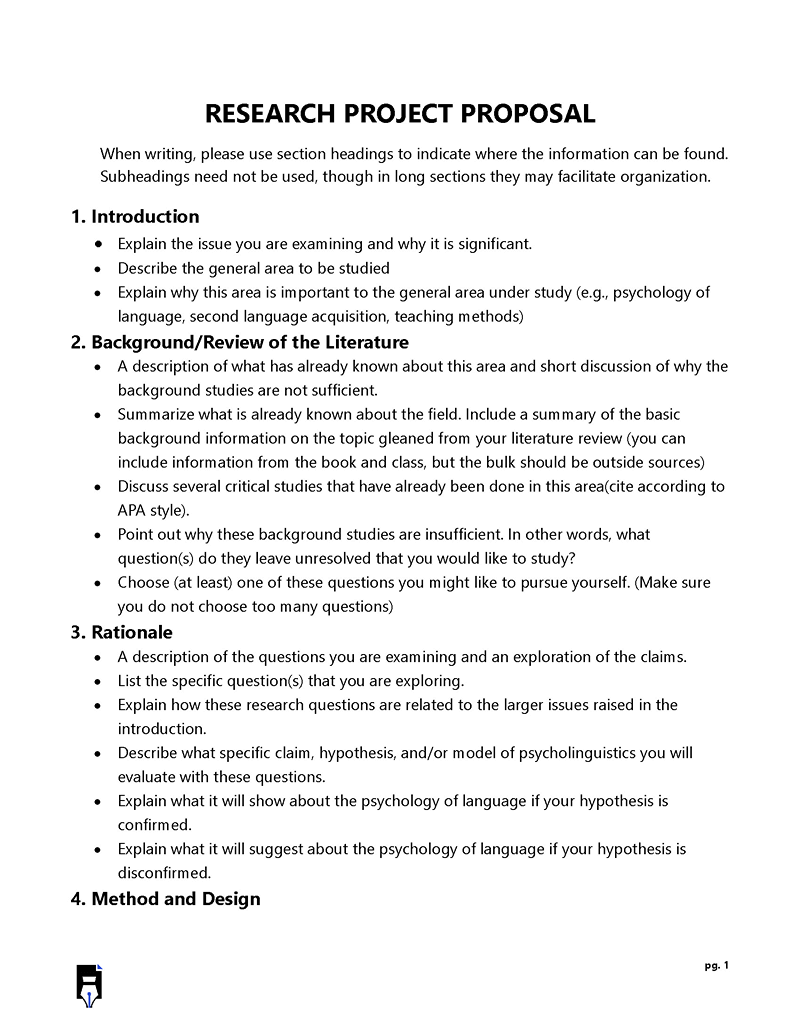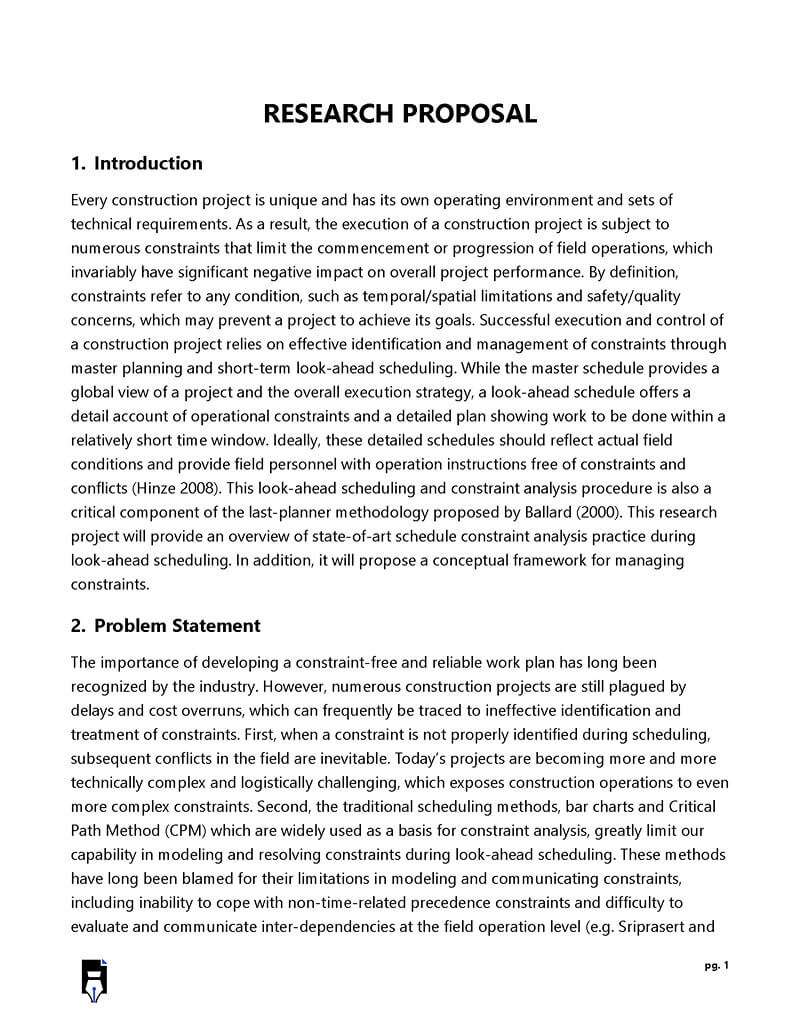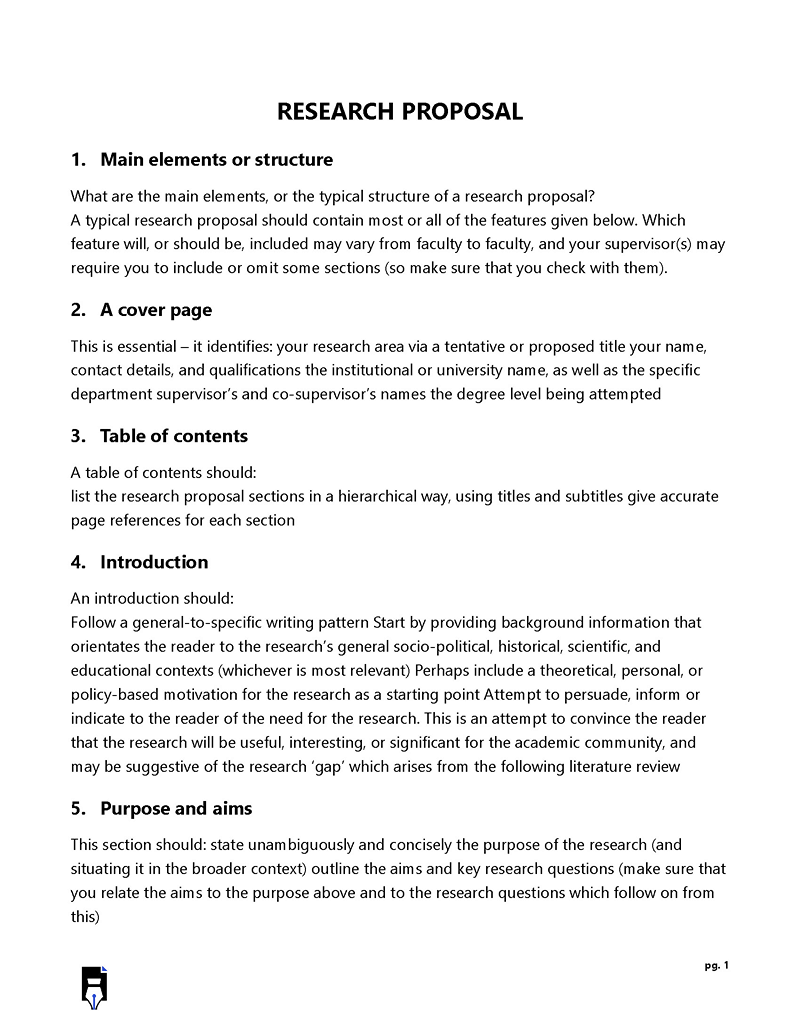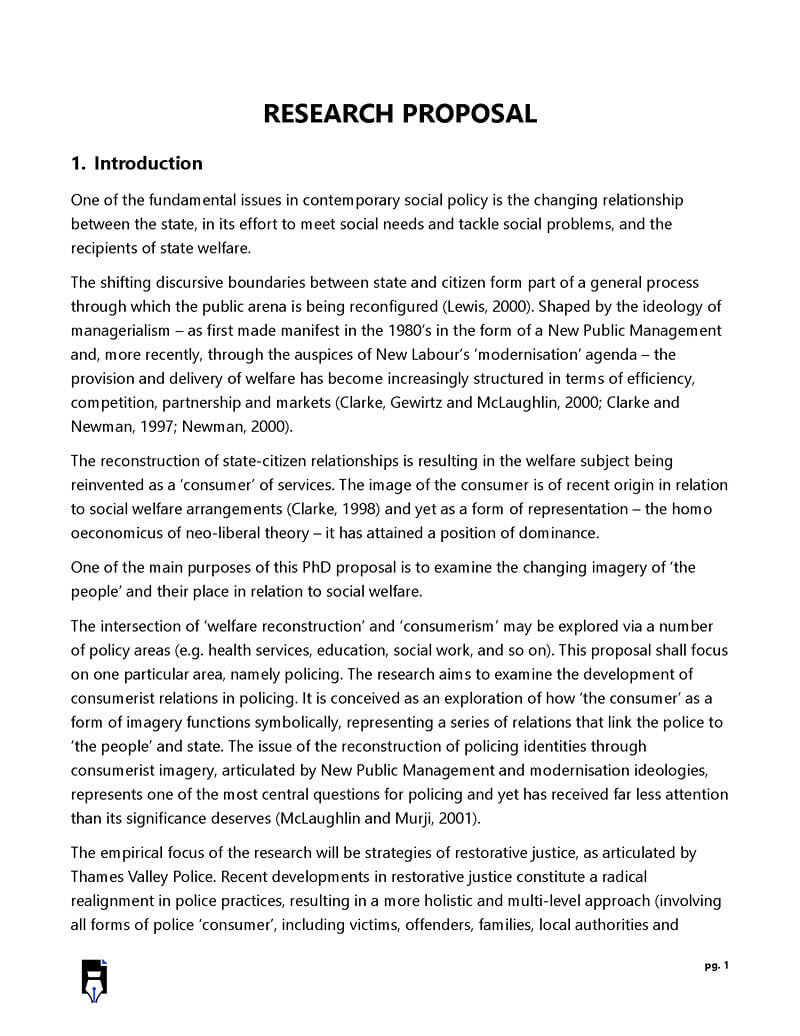A research proposal is a structured document that describes a particular research project, generally in academia. It provides a detailed outline of the topic that you want to investigate, its significance, and the methodology that will be used for it. Additionally, it is also used to apply for grants and funding for projects.
In most cases, a proposal has the following sections: an introduction, a research question, a literature review, a proposed methodology, and the significance of the study. Proposing a research project is not simple and requires extensive study and accurate information.
Once the proposal is completed, it is usually presented to your supervisor or a qualified individual with expertise in the same discipline.
While working on presenting a research project, you should keep these factors in mind:
- The proposal should outline exactly what the project will be about. In other words, the proposal should highlight your research topic. It should clearly state what is being investigated, who your target audience is, and the methods that will be used in the study.
- You must clearly outline the contribution of your research in your discipline. It is important to understand the impact that your research will have on the current literature and how it will fill a gap in the existing knowledge in that area. Furthermore, you need to show why your study is relevant.
- You need to accurately explain how you will conduct the research and the methods that you will use to test your hypothesis and express clearly that your plan is attainable based on your skills and the available resources.
- Finally, you will also have to provide a detailed explanation of the analysis techniques that will be used to test your hypotheses. You would have to provide a justification for the suitability of your chosen analysis technique for your study.
Research Proposal Templates and Examples
A research proposal should accurately describe a research project. Therefore, it is crucial that the document conforms to academic guidelines and also contains all necessary information. You can use our templates and examples to prepare a perfect research proposal. Our templates will save you time and effort.
Furthermore, you can customize these templates according to your requirements. You can access and download our templates for free from the links below. The essence of these templates is to ensure that you can prepare, complete, and submit your proposal within the given timeline.
4 Aspects a Research Proposal Aims to Cover
Conducting a unique study, that investigates something valuable is an important milestone for any academic, and a well-written proposal will be the first step toward achieving this goal. The primary purpose of a research proposal is to convince the supervisor or the institution that your proposed study is worth serious consideration. A well-written document will not only be helpful in securing the required funding but will also strengthen your position as a skilled professional in your field.
Here are the aspects you should cover in your proposal:
Relevance
It is necessary to show the supervisor and the institution that your project is interesting, unique, and relevant to your research field.
Context
In your proposal, it is crucial to show the reader that you have a clear and in-depth understanding of your research topic. This will show the readers that you are familiar with the latest developments in your field.
Approach
Your proposal should explain the hypothesis and the approach you will use to collect data. It should also clearly mention the data analysis techniques that will be used. In other words, the proposed methodology should be clearly stated.
Feasibility
The proposal should prove that you will be able to complete the project within the given time using the available resources. Therefore, you must provide a timeline of your project with clear deliverables at every stage to prove the feasibility of your study.
How is an Effective Research Proposal Structured?
As a researcher, there are specific details that you should include in your proposal to make it thorough and effective. Below is a guide on the information that you should include in your proposal if you wish to get the approval and resources needed for your research project:
Cover page
Also known as the title page, the cover page will contain the title of your proposal, your full name, the full names of your fellow investigators, the name of your supervisor, and your institutional and departmental affiliation.
Main components
For the second part, your proposal should contain the following main components that are important if you want to have an effective document:
- Abstract: Begin with an abstract that will outline the main focus of your research. This will entail the purpose and reason for the study, the research problem, the methods to be used for data collection, the expected results, and the contribution of the study. Since this document is meant to act as a blueprint for the study you intend to perform, your abstract should provide the reader with a brief summary of your proposed project. Additionally, this section should be interesting enough to attract the attention of the reader.
- Research Question: The research questions must state clearly what your proposed study is meant to address or answer. Ensure that you use simple language that is easy to understand while being cognizant of the level of your intended audience.
- Literature review: The literature review provides an overview of the most pertinent and recent studies in your field. Most resources for academic literature are now available online. The purpose of conducting a review of all the relevant literature is to develop knowledge about your own study and also to find the gaps in the existing literature. A thorough literature review provides the background for your own research project by contrasting theories, examining the benefits and drawbacks of various methodologies, and providing more detail on the knowledge that is already known. Ensure that the information you include in this section is organized properly to help readers understand your work and how it relates to the work of other researchers. All the studies represented in this section should be properly cited according to the relevant referencing guidelines for your discipline.
- Aims and objectives: The next part is the “aims and objectives” section, where you need to indicate the goal or purpose of your research. Testing the hypothesis is generally the aim of your study because that is what you intend to achieve if your proposal is approved. While the aim of the study provides a broad statement, the objectives of the study will explain how you will achieve the main goal. Usually, objectives are divided into various smaller parts and listed as such.
Tip: A research aim usually refers to the general purpose of your research, while a research objective specifies how you will achieve the aim. The research aim should be included in your introduction after your problem statement but before your research objectives.
Research design and methods
The methodology section will provide an overview of the research design and the proposed methods of data collection. You will discuss why this is the appropriate method in light of the literature review. Ensure that you provide proper references about your chosen methodology and support it from the existing literature.
To efficiently write this section, you should include the following components:
- Population and sample: Population is all the elements that meet the criteria for being included in the research and is studied with the purpose of drawing conclusions. While, a sample is the subset of the population, contains its characteristics, and is studied with the purpose of collecting data. You also need to specify the inclusion and exclusion criteria.
- Data collection methods: You need to indicate the methods you will use to collect data. The methodology should be suitable for your proposed study and also be consistent with the time frame of your project. Data can be collected through primary and secondary data sources. Primary data collection methods include surveys, observations, physical testing, mailed questionnaires, a questionnaire filled and sent by enumerators, personal interviews, telephonic interviews, focus groups, case studies, etc. Secondary data collection methods include data collected from existing sources like censuses, government publications, internal records of the organization, reports, books, journal articles, websites, and so on. It is also important to mention any limitations of your study here and how you plan to address them
- Data analysis techniques: Finally, the proposed data analysis technique should also be clearly stated. Make sure to cite examples from the existing literature to support your choice of technique and to describe its advantages.
Significance of the study
The researcher must provide justification for the need to conduct the study. They must explain the gap that the study will fill and its contribution to the existing body of knowledge. The impact of the study on the subject field must also be indicated.
Ethical considerations
The proposal should also have a section on ethical considerations that you intend to adhere to when collecting your data. It will detail the special care you will take to achieve ethical research standards, such as obtaining informed consent, contacting appropriate authorities, and protecting the rights of your participants.
Budget
Your proposal should also include a budget for the expected costs and any additional allowances for unforeseen situations. Include the exact amount you will need for your project, then justify your budget by providing a breakdown of why each cost is important and providing the source of how you calculated the total amount. This will make your budget appear credible, and you are likely to secure funding for your research.
When preparing your budget, focus on the travel costs you might incur when collecting data, the materials or tools you will need for the study, and any help you might outsource, such as research assistants.
Appendices
Any additional information, such as graphs or tables, can be added to this section. This section is useful for providing clarification or supplementary documents related to the study.
Bibliography
Provide proper references to the academic works that you have used for preparing your document. Make sure the bibliography is properly formatted in accordance with the institute’s rules.
How Long Should a Research Proposal Be?
A research proposal’s length varies depending on the degree it is intended for, such as a bachelor’s, master’s, doctoral, or grant application. A master’s proposal is about 2000–3000 words, while a Ph.D. proposal is about 5000–8000 words. Also, the length may vary based on your institution and field of study. Some universities might require an outline for your proposed study, while others might need a detailed document with the first three chapters.
Ensure that you ask your supervisor about the exact guidelines regarding the length of the document. Remember that your proposal must be shorter than your project since it does not contain the findings, conclusion, and discussion sections.
Some Tips to Consider
There are some important tips that you should consider when preparing your research proposal to ensure that you have an effective and detailed document. These include the following:
- Use terms such as ‘It is evident that…’ instead of ‘It seems like….’ to appear confident and convincing.
- Use bullet points and smaller sub-sections instead of overly packed and long paragraphs.
- Ensure that you include the limitations of your study and the ways you plan to address them to improve your proposal.
- Ensure that you arrange the content in a logical manner so as to facilitate easier reading and better understanding.
- Review other research proposals in your field to guide you when writing your own documents, such as using proper formatting and structure.
- Ensure that your proposal indicates how feasible and logical your project will be.
- Properly formulate your research questions, detailed research objectives, and hypothesis.
- The literature review must be thorough and contain recent studies.
- Clearly outline the gap in the existing knowledge on the subject to signify the relevance of your study.
Final Thoughts
Your research proposal should convince the readers that your study will have a significant impact on your field of study. Therefore, it should be unique and provide a clear methodology to answer the research questions. A well-structured and detailed document will allow the readers to get a clear understanding of what you are trying to achieve with your project. The document should be properly formatted and follow the guidelines and instructions provided by the institute.
Therefore, it will be easier to get financial support if you have a strong and convincing proposal. Furthermore, your project should complement the goals of your institution and be easily attainable.
